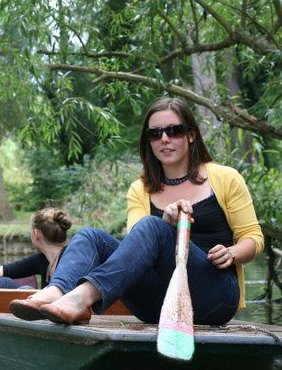 On Monday morning I was enjoying my porridge and watching my old favourites, Bill and Susanna on BBC breakfast (I really do love Bill and Susanna), when they mentioned that the new National Curriculum for 2014 had been released, and shock horror, the topic of evolution was to be introduced at primary age for the first time. “Hoorah!” I exclaimed out loud, despite being by myself. But when I rushed to the computer to find the updated curriculum I was less than impressed.
On Monday morning I was enjoying my porridge and watching my old favourites, Bill and Susanna on BBC breakfast (I really do love Bill and Susanna), when they mentioned that the new National Curriculum for 2014 had been released, and shock horror, the topic of evolution was to be introduced at primary age for the first time. “Hoorah!” I exclaimed out loud, despite being by myself. But when I rushed to the computer to find the updated curriculum I was less than impressed.
What exactly are you scared of?
The National Curriculum is Evolving
One of the main reasons I first sat down and started writing “Little Changes” was because I felt the national curriculum did not provide a good foundation at an early enough age, in regards to teaching evolution. It tended to focus on adaptation as a rather static process, “fish have fins to swim, birds have wings to fly, hence fish live in the sea and birds fly in the sky”. I’m not saying this is how all teachers chose to teach the topic – I’m sure there were fantastic efforts to try and introduce evolution with more life and excitement. But the fact is it was not expected or even encouraged, it is only those teachers that had a personal interest or that were prepared to go above and beyond their call of duty that would have provided children with this knowledge. And for you courageous few, I thank you.
However, in June 2012 a draft of the updated national curriculum was released, and I was thrilled to see evolution on the agenda. Previously, pupils at key stage 2 (between 7 and 11 years) were expected to know “about the different plants and animals found in different habitats” and “how animals and plants in two different habitats are suited to their environment”. The subject was then abandoned until year 10 (14-15 years), which was the first stage at which evolution was explicitly discussed. The new standards state that in year 4 (8-9 years old) pupils are expected to understand the basics of inheritance – without necessarily understanding genes and chromosomes – and the key concepts of adaptation through learning the evolutionary history of our hominid ancestors over millions of years. “Hoorah!” Even better, this knowledge is built on in years 5 and 6 when with the introduction of variation, and evidence supporting evolution from the fossil records.
I was particularly impressed with the use of human evolution as an example of gradual change over time, because I would imagine for some religious parents this is one of the areas of evolution that they are very reluctant to accept. However, evidence doesn’t lie – and I think the national curriculum has taken a very positive step forward in debunking the false controversy which still surrounds evolution today. Education should not be censored for fear of offending the uninformed few. Children should be offered all the facts – and the choice as to whether or not to accept them should be their decision, not ours.
Well done Britain, I’m proud of you.
You can see the draft of the national curriculum for key stages 1 and 2 here: http://media.education.gov.uk/assets/files/pdf/d/draft%20national%20curriculum%20for%20science%20key%20stages%201%202.pdf
And I’m sure this change was in no small part due to some hard campaigning from the British Humanist Association (BHA), check out their campaign here: http://evolutionnotcreationism.org.uk/
“I thought tweeting was for birds!”
 The last week was one of great excitement and mild panic. Just a few little words on PZ Myers’s blog and twitter account, “We need a lot more of these. Check out Little Changes by Tiffany Taylor”, was enough to convince 3000 people to visit my Little Changes website. For those of you who are new to my blog, “Little Changes” is a children’s book which introduces the concepts of evolution to a young audience, without the jargon.
The last week was one of great excitement and mild panic. Just a few little words on PZ Myers’s blog and twitter account, “We need a lot more of these. Check out Little Changes by Tiffany Taylor”, was enough to convince 3000 people to visit my Little Changes website. For those of you who are new to my blog, “Little Changes” is a children’s book which introduces the concepts of evolution to a young audience, without the jargon.
This, while obviously incredibly exciting, made me realise how completely unprepared and inept I was. My brother-in-law kindly pointed out there was a bit of a discussion going on via twitter on my aforementioned book – and that I needed to sort myself out and get on it! The trouble was, I knew about as much on how to use twitter as I did about the latest One Direction “hit”. A revelation came with the discovery of the “Search” and “@Connect” buttons (yes I have a PhD, and yes I really was that slow on the uptake). And with a little revamp of my outdated profile I think I can safely say, “My name is Tiffany, and I’m a twitterholic (but I still have no idea what the latest One Direction hit is).”
Thanks to those who shared, and who still share. The “Little Changes” project is itself evolving, into something which I hope will help young children question the why the world they live in, is the way it is. There are exciting things on the horizon for Little Changes, so watch this space!
On that note, the rinkdinks get a mention on this week’s “Naked Scientists” genetics podcast (between time 21:12 and 24:01, but make sure you give the whole thing a listen as there’s some fascinating stuff on there like “how genes might jump between snakes and cows”?!) A big thank you to Kat Arney for her superb interviewing and editing skills – I’m sure I didn’t sound that coherent at the time.
Meet the rinkidinks (www.rinkidinks.co.uk)
Almost a year ago I was sitting on the train home, on my daily commute from Reading to Ash Vale. I’d had a long day in the lab, and I was flicking through my note book trying to make sense of some data I had collected earlier. Frustrated and confused by my bizarre results I began doodling some pictures, and by the time I arrived at Ash Vale I had a little story board sketched. This story told the tale of a group of animals with funny tails, that became split between two habitats. These habitats presented different challenges, and in order to survive the creatures had to adapt. In the end, little changes added up to make big differences.
I’d been thinking about writing a book about evolution for children for a while. Evolution is a dynamic process, ever changing, and only those which can keep up with the pace will survive. This is one of reasons I became so interested in evolution, it was the realisation that survival is a constant struggle. We are here because a long unbroken line of ancestors has managed not only to survive, but to reproduce for the last 4 billion years. When you work out the maths, the probability of you even being alive is incredibly small (in fact, if you want the rough numbers you can find them here). I felt the excitement and wonder of evolution was lost in current teaching methods, and so I wrote this book in order to introduce the concepts of evolution, without the jargon, in a fun and comprehensible way, with the hope of encouraging questions about the world we live in, and getting kids wondering why things are the way they are.
I am a singer/ songwriter, and so writing in a lyrical format came naturally to me. I’ve always found the poetic style much easier to get away with clichés and create imaginative images. Once written I had to decide what to do with it! I wrote to a few agents and thought about finding a publisher – but the truth is it’s very time consuming, and with a full time job I was feeling the strain. So I decided on a different plan of action, and applied for a grant from the ESEB outreach fund (if anyone is keen on getting involved in an evolutionary based outreach project I urge you to apply).
They kindly gave me the money to make my book into an educational resource for schools. A huge step forward for the project was the addition of the incredibly talented illustrator James Munro to the team. James took the words I had written and brought them to life. To literally watch the rinkidinks evolve on the page was hugely exciting.
In early 2013 I’m hoping to introduce the book to local schools and get some feedback on how the students respond and whether they learn anything new.
And so now, I am so excited to introduce you to the rinkidinks. You can read the book at here.
Read, enjoy, and please share if you like it.
 You may, or may not, have been made aware of the fact that today is national poetry day. Personally, I love poetry. As a child my favourite books were (and probably still are) Roald Dahl’s “Revolting Rhymes”, and Colin McNaughton’s “Who’s Been Sleeping in My Porridge?” – and if you haven’t experienced either book I insist you head straight to the library.
You may, or may not, have been made aware of the fact that today is national poetry day. Personally, I love poetry. As a child my favourite books were (and probably still are) Roald Dahl’s “Revolting Rhymes”, and Colin McNaughton’s “Who’s Been Sleeping in My Porridge?” – and if you haven’t experienced either book I insist you head straight to the library.
I dabble in my own poetry writing. Usually silly and nonsensical, because for me, poetry has always been about having fun with words. I’ve also always used it as a tool for learning. In school, when I was trying to memorise some complicated formula or list of scientific jargon, I would do my best to create a rhyme out of the problem – and chances were if I was successful, the exam was usually kind to me. Read the rest of this entry »
Poetic Projects
Darwin’s place in medicine
 Before human intervention the rules of disease were simpler. The competitors: pathogen vs. host. The rules: in order to win, the pathogen must ‘divide and conquer’, attacking the host’s defences and increasing in numbers; the host, on the other hand, must stay strong and defend hard in order to keep a united front, before finally striking back and wiping out the invaders. It was a game of risk, and the winner would ultimately find themselves stronger and better prepared for the next battle. This is because the hosts and pathogens necessarily need to coevolve – that is to adapt to each other simultaneously – in order to stay in the game. This concept was famously captured in a quote by the Red Queen in Lewis Carroll’s ‘Through the Looking-Glass’,
Before human intervention the rules of disease were simpler. The competitors: pathogen vs. host. The rules: in order to win, the pathogen must ‘divide and conquer’, attacking the host’s defences and increasing in numbers; the host, on the other hand, must stay strong and defend hard in order to keep a united front, before finally striking back and wiping out the invaders. It was a game of risk, and the winner would ultimately find themselves stronger and better prepared for the next battle. This is because the hosts and pathogens necessarily need to coevolve – that is to adapt to each other simultaneously – in order to stay in the game. This concept was famously captured in a quote by the Red Queen in Lewis Carroll’s ‘Through the Looking-Glass’,
“Well, in our country,” said Alice, still panting a little, “you’d generally get to somewhere else — if you run very fast for a long time, as we’ve been doing.”
“A slow sort of country!” said the Queen. “Now, here, you see, it takes all the running you can do, to keep in the same place. If you want to get somewhere else, you must run at least twice as fast as that!”
However, since modern medicine came along, the dynamics of the game have become more complex; and it is only recently that evolutionary biology has been considered a potential weapon against disease – by trying to predict and manipulate the pathogen’s strategies, in order to stay one move ahead. The application of evolutionary theory to understanding health and disease is known as evolutionary or Darwinian medicine – and it is being used to try and find answers for all sorts of medical ailments, such as: autoimmune diseases, diabetes, anxiety disorders, antibiotic resistance, and cancers (to name just a few). As such, Darwin – the “medical school dropout” – turns out to be having a bigger impact on the world of medicine than he could ever have imagined.
An Insect-or Calls
A blood curdling scream disturbs what was otherwise a calm summer’s eve, and then all was deathly silent again. The butler comes running into the reading room looking distressed,
“It’s the gardener ma’am, she’s found something in the rose bushes. It’s a young man. It’s the body of a young man!”
“Not to worry”, a voice pipes up from the corner of the room, “I’m an entomologist”. The others look at each other bemused, “The name’s Crawley, Dr Carrie P. Crawley”.
The Age of the Phage
We are in the middle of a war that has been raging for several billion years, and its continuation is certain for as long as life exists on our planet. The number of bacteria on earth has been estimated at 4-6 x 1030 cells,equal to approximately 350 – 550 Pg of carbon (1Pg = 1015 grams). That’s a lot of carbon for a little thing. For a long time, bacteria were thought to be the most abundant and diverse organisms on the planet, but for every organism there is a parasite, and the bacteria’s mortal enemy is the phage (or the bacteriophage as it is also known). Phages are viruses of bacteria, and outnumber their hosts 10 to 1. Every day, these viruses kill half the bacteria living in the oceans, and they are infecting bacteria all over the world at a rate of 10 trillion times a second. But we didn’t even know they existed until the 20th century. Read the rest of this entry »
The Silent Scientist… Speaks
I apologise for my recent absence over the last few months. During my silence I have been lacing my thesis with blood, sweat and many tears – and on the 9th of September I earned my DPhil from Oxford University.
So now, with my silence broken, Dr. Taylor is back in business taking “a journey through the science of life”, and hopefully finding the words to take you with me.
Thank you to all those who supported me during my time at Oxford, and its with excitement and a little nostalgia that I now move onto the next stage of my academic career as a postdoc at Reading University.
Real science to follow soon… I promise.
In Brief: “Sticks and stones may break my bones, but ‘thunder-thighs’ will kill me!”
Most of us have nicknames from our youth we’d rather forget, and we can only hope they don’t follow us into adulthood, but for one unlucky dinosaur 110 million years isn’t long enough.
Recently, specimens from a newly discovered sauropod, dating back to the Early Cretaceous period, were uncovered in Utah. This new addition to the family has been given the name Brontomerus mcintoshi – from the Greek words “bronto“, meaning “thunder”; and “merós“, meaning “thigh”. Thunder thighs?! Charming.
The scientific justification for this unflattering nickname is the unusually large hip bone the creature possesses. Comparatively, it is significantly larger than that of similar species. This bulky bone would have provided anchorage for hefty thigh muscles. Interestingly, the skeletal structure does not seem to provide support for strong muscles on the back of the leg to pull it along, suggesting these muscles were not used for speed, but power.
Paleo-scientists believe ‘Thunder-thighs’ would have been able to administer a strong kick to potential sexual opponents and predators. And at a predicted adult weight of six tonnes, I would not want to provoke this undercover ninja. All together now, “Everybody was kung-fu fighting, huh”…





